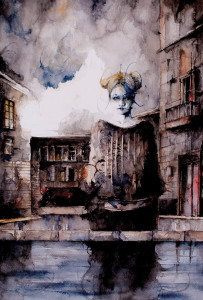Dreams from the Witch House: Female Voices of Lovecraftian Horror edited by Lynne Jamneck, illustrations by Daniele Serra
Dark Regions Press, 2016
ISBN 9781626411111 (ebook)
Available: Pre-order Kindle ebook, hardcover, trade paperback
I haven’t contributed financially to many Indiegogo projects, but when I saw the announcement for Dreams from the Witch House: Female Voices of Lovecraftian Horror, I knew I couldn’t pass it up, and I’m very glad I did not.
Dreams from the Witch House is a collection of twenty weird fiction stories, each one set in various times and places with characters and themes that resonate with the reader long after the tales have concluded. I had to take some time to mentally process each tale after I read them. The authors have crafted tales that really impact the reader. It’s hard to even say which one is my favourite since they each have their own distinct qualities. From the firs t story by the legendary Joyce Carol Oates (what a way to start a book!) to the last, each story has so much complexity and succeed in evoking different emotions in such short page space. I found that I have something to say about every one of these stories, but I have selected a few that really stand out.
t story by the legendary Joyce Carol Oates (what a way to start a book!) to the last, each story has so much complexity and succeed in evoking different emotions in such short page space. I found that I have something to say about every one of these stories, but I have selected a few that really stand out.
“Shadows of the Evening” by Joyce Carol Oates is the story of Magdalena Schӧn told by her granddaughter. After being forced to leave home, Magdalena finds herself living with her wealthy great-aunt, Erica Kistenmacher to whom she is to be a companion. Finding that she has ample free time, she takes to wandering the streets of her new town. She is beckoned by a handsome voice singing a haunting song. She finds the owner of the voice, and he changes her forever.
Tamsyn Muir’s “The Woman in the Hill” is written in the form of a letter from Caroline, a woman who is afraid she is losing her mind. After her friend Elizabeth tells her of finding a door in a hill, she disappears mysteriously. Caroline discovers Elizabeth wasn’t the first to disappear, and most certainly won’t be the last.
“Pippa’s Crayons” by Christine Morgan is a story of a child whose crayons, crafted by her grandfather, display colours not of this world. Despite the short length of this story, Morgan has written an incredibly chilling story.
“Cthulhu’s Mother” by Kelda Circh injects some humour into the collection with a conversation between cultists of Cthulhu and the rather strict mother of the Sleeper of R’lyeh.
In addition the previously named authors, other women who have lent their writing skills to Dreams from the Witch House are, Collen Douglas, Cat Hellison, Caitlin R. Kiernan, Lucy Brady, Marly Youmans, Sanya Taaffe, Gemma Files, Molly Tanzer, Karen Heuler, Lois H. Gresh, Nancy Kilpatrick, E.R. Knightsbridge, Amanda Downum, Storm Constantine, R.A Kaelin, Elizabeth Bear and Sarah Monette, with full colour artwork by Daniele Serra. Introduction by editor, Lynne Jamneck.
I recommend this collection to anyone who enjoys incredible weird fiction. I was not disappointed with any of the stories. The artwork that Serra created for each story are beautifully rendered. To date, I have only had access to the ebook. The paperback version is still forthcoming.
Highly recommended
Contains: mild body horror, sexuality
Reviewed by Lizzy Walker










Follow Us!